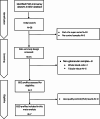Transcriptome meta-analysis and validation to discovery of hub genes and pathways in focal and segmental glomerulosclerosis
- PMID: 39232654
- PMCID: PMC11375834
- DOI: 10.1186/s12882-024-03734-4
Transcriptome meta-analysis and validation to discovery of hub genes and pathways in focal and segmental glomerulosclerosis
Abstract
Background: Focal segmental glomerulosclerosis (FSGS), a histologic pattern of injury in the glomerulus, is one of the leading glomerular causes of end-stage renal disease (ESRD) worldwide. Despite extensive research, the underlying biological alterations causing FSGS remain poorly understood. Studying variations in gene expression profiles offers a promising approach to gaining a comprehensive understanding of FSGS molecular pathogenicity and identifying key elements as potential therapeutic targets. This work is a meta-analysis of gene expression profiles from glomerular samples of FSGS patients. The main aims of this study are to establish a consensus list of differentially expressed genes in FSGS, validate these findings, understand the disease's pathogenicity, and identify novel therapeutic targets.
Methods: After a thorough search in the GEO database and subsequent quality control assessments, seven gene expression datasets were selected for the meta-analysis: GSE47183 (GPL14663), GSE47183 (GPL11670), GSE99340, GSE108109, GSE121233, GSE129973, and GSE104948. The random effect size method was applied to identify differentially expressed genes (meta-DEGs), which were then used to construct a regulatory network (STRING, MiRTarBase, and TRRUST) and perform various pathway enrichment analyses. The expression levels of several meta-DEGs, specifically ADAMTS1, PF4, EGR1, and EGF, known as angiogenesis regulators, were analyzed using quantitative reverse transcription polymerase chain reaction (RT-qPCR).
Results: The identified 2,898 meta-DEGs, including 665 downregulated and 669 upregulated genes, were subjected to various analyses. A co-regulatory network comprising 2,859 DEGs, 2,688 microRNAs (miRNAs), and 374 transcription factors (TFs) was constructed, and the top molecules in the network were identified based on degree centrality. Part of the pathway enrichment analysis revealed significant disruption in the angiogenesis regulatory pathways in the FSGS kidney. The RT-qPCR results confirmed an imbalance in angiogenesis pathways by demonstrating the differential expression levels of ADAMTS1 and EGR1, two key angiogenesis regulators, in the FSGS condition.
Conclusion: In addition to presenting a consensus list of differentially expressed genes in FSGS, this meta-analysis identified significant distortions in angiogenesis-related pathways and factors in the FSGS kidney. Targeting these factors may offer a viable strategy to impede the progression of FSGS.
Keywords: Angiogenesis; Focal and segmental glomerulosclerosis; Meta-analysis; Therapeutic target; Transcriptome.
© 2024. The Author(s).
Conflict of interest statement
The authors declare no competing interests.
Figures





Similar articles
-
An Integrative in silico Study to Discover Key Drivers in Pathogenicity of Focal and Segmental Glomerulosclerosis.Kidney Blood Press Res. 2022;47(6):410-422. doi: 10.1159/000524133. Epub 2022 Mar 18. Kidney Blood Press Res. 2022. PMID: 35306494
-
Bioinformatic Analysis Combined With Experimental Validation Reveals Novel Hub Genes and Pathways Associated With Focal Segmental Glomerulosclerosis.Front Mol Biosci. 2022 Jan 4;8:691966. doi: 10.3389/fmolb.2021.691966. eCollection 2021. Front Mol Biosci. 2022. PMID: 35059432 Free PMC article.
-
Identification of key genes and biological regulatory mechanisms in diabetic nephropathy: Meta-analysis of gene expression datasets.Nefrologia (Engl Ed). 2023 Sep-Oct;43(5):575-586. doi: 10.1016/j.nefroe.2022.06.006. Epub 2023 Jan 19. Nefrologia (Engl Ed). 2023. PMID: 36681521
-
Hidden genetics behind glomerular scars: an opportunity to understand the heterogeneity of focal segmental glomerulosclerosis?Pediatr Nephrol. 2024 Jun;39(6):1685-1707. doi: 10.1007/s00467-023-06046-1. Epub 2023 Sep 20. Pediatr Nephrol. 2024. PMID: 37728640 Free PMC article. Review.
-
Focal Segmental Glomerulosclerosis.Clin J Am Soc Nephrol. 2017 Mar 7;12(3):502-517. doi: 10.2215/CJN.05960616. Epub 2017 Feb 27. Clin J Am Soc Nephrol. 2017. PMID: 28242845 Free PMC article. Review.
References
-
- Valencia VC, de La Cruz CO, Fuentes JB, Ramírez FF, Michel RP, Aragaki Y, Magaña IM, Villaseñor HP, Pérez MV, Cárdenas MG. Epidemiology of glomerular disease in adults: a database review. Gac Med Mex. 2014;150(5):403–8. - PubMed
Publication types
MeSH terms
LinkOut - more resources
Full Text Sources
Miscellaneous

